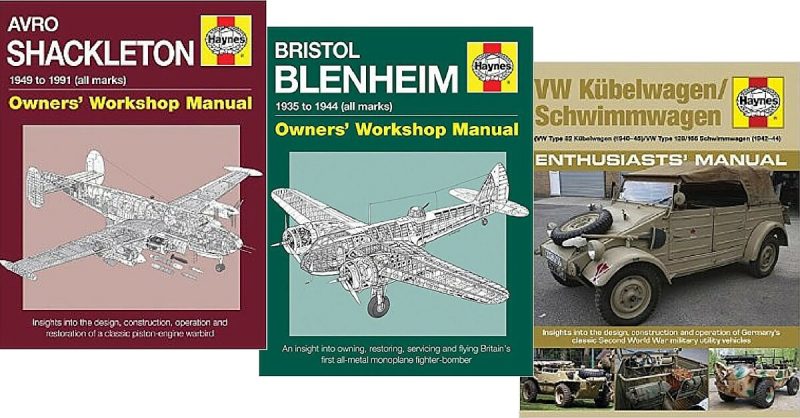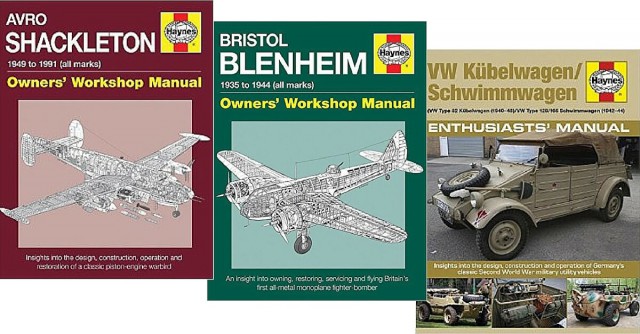Well, playmates, Armistice Day and Bonfire Night are behind us and now that British TV is awash with adverts for it I feel safer about using the C-word: Christmas.
I think it is fair to our chums in the publishing world that we give you folks all the info you may need to have ideas when you are asked those awkward questions by wives, in-laws and well meaning aunties (other nearest and dearest are available). With this in mind I will be dropping in the odd round up to my corner of WHO as opposed to my sporadic lengthier stuff.
We get off to a blistering start with these three excellent books from Haynes Publishing.
Keith Wilson must be chillaxing at a spa somewhere because this is the second of three books my him I will review before all the pre-Santa sleeps are used up and he must be knackered. I know from doing one book how hard it can be. This time round he turns his attention to the wonderful Avro Shackleton with a traditional owner’s workshop manual. The last time I saw one of these aircraft at work was at RAF St Mawgan way back in 1983. On the same day a NATO liveried AWACS was doing circuits and bumps and the end of the prop driven era was well and truly in sight.
The Shackleton’s lineage goes all the way back to the Manchester and Lancaster and continued via the Lincoln. It is, however, a very different beast to those old girls and although many of the construction aspects were similar, the role and conditions the Shackleton was built for were much different. I have to say I love the things and the only photograph of an aeroplane I have up in my house is of a pair in flight.
Mr Wilson’s knowledge and passion for aircraft of the post-war era and his understanding of technical gubbins that goes way over my head is all evident in this lovely book. We get all the usual Haynes manual ingredients and there you will not be disappointed.
Somewhat different is Dr Chris McNab’s treatment of the Kubelwagen and Schwimmwagen in this neat Enthusiast’s Manual. The actual look and feel of this book is barely different from its stable-mates but there is something more of a generic and history telling feel to this book. The author has to get his skates on because there is actually a lot to talk about and it is surprising how many variants and modifications were made to these two classics. I know a gentleman who has a number of them and I was stunned to see the differences when it was possible to compare like for like.
As ever, the archive photography and cleanness of the layout is uber appealing and the package works as a really nice ‘go to’ when you have questions about the vehicles. When I first looked at it my immediate thought was it lacked a bit of weight, but closer inspection blows that notion away. I think the problem is that I associate these new era manuals with complex machinery in the form of aircraft and a step back to Haynes’ roots with things on four wheels is a little odd. My old boss Pat Ware has done a few on other MVs, but although I have only seen one of them, it really worked for me. So, the message is all positive. I can definitely recommend this neat and attractive book.
Lastly we have a belter from Jarrod Cotter. Once again the in-joke about an Owners’ Workshop Manual for something as rare as rocking horse poo is all good fun but, as ever, this is a very serious book.
I was at Duxford in September to see the principal star of this package buzzing around with all the grace and elegance I had hoped for. The Bristol Blenheim means so much because it was such an important aircraft in the early years of the war when it had to fulfil so many tasks before American types and the Mosquito came along. It is an absolute classic and the only flying example is a perfect memorial to the huge number of men who fought in them.
As everyone with an interest is aware, the source for Blenheim bits is largely found in her surviving Bolingbroke relatives from Canada. Restorations have had their ups and downs but the current flying example is a thing of beauty and although I prefer the longer nosed later varieties to look at, the Mk1 is a lovely thing to see. I had the pleasure of handling pre-war negatives of the Type 142 prototype a while back and the modernity of it is very apparent, even though it would be all too quickly eclipsed by other aircraft. I will grudgingly admit this snub nosed type is a handsome looking aeroplane and the surviving L6739 looks glorious up close.
Mr Cotter takes us through all the usual elements of a Haynes Manual and I know I am repeating myself when I say the use of photography and the style of the thing is wonderful. The technical illustrations have a particular appeal and the manner of the way the aeroplane is dissected is so easy to follow it made me feel much less of a mechanical dunce.
All three of these books will give you an excuse to miss the Downton Abbey Christmas special (unless of course you don’t want to!) and I am all in favour of that. Enjoy!
Reviewed by Mark Barnes for War History Online.
AVRO SHACKLETON

1949-1991 (all marks)
Owners’ Workshop Manual
By Keith Wilson
Haynes Publishing
ISBN: 978 0 85733 769 6
VW KUBELWAGEN/SCHWIMMWAGEN

VW Type 82 Kubelwagen (1940045)/VW Type 128/166 Schwimmwagen (1942-44)
Enthusiast’s Manual
By Dr Chris McNab
Haynes Publishing
ISBN: 978 0 85733 779 5
BRISTOL BLENHEIM

1935-1944 (all marks)
Owners’ Workshop Manual
By Jarrod Cotter
Haynes Publishing
ISBN: 978 0 85733 812 9

